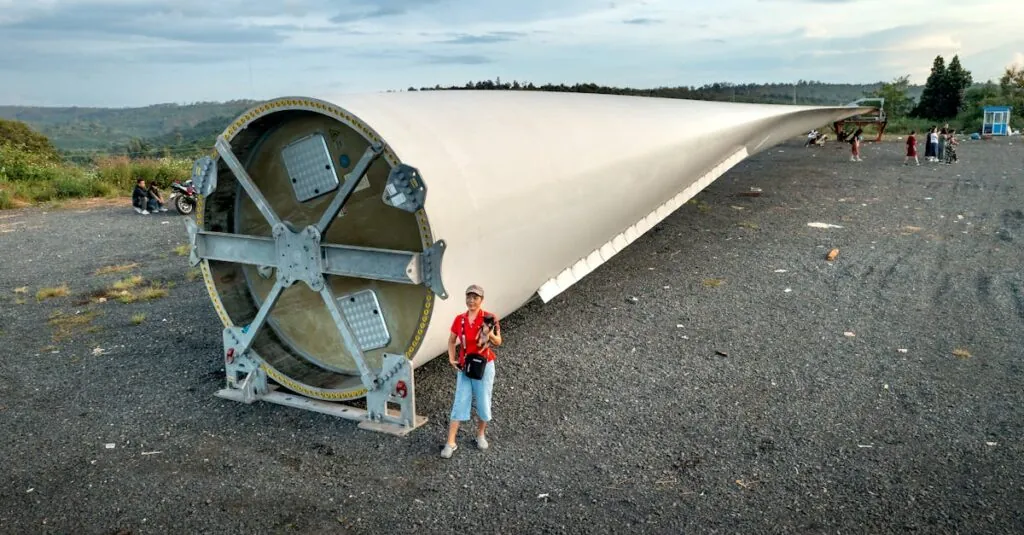In a world where fossil fuels are becoming as popular as dial-up internet, renewable energy technology is stepping up to save the day. Picture this: solar panels soaking up sunshine like a beachgoer on vacation, wind turbines spinning gracefully like dancers in a breezy ballet, and hydroelectric plants harnessing the power of rivers as if they were nature’s own energy drink. It’s not just a trend; it’s a revolution, and it’s here to stay.
As the planet warms up faster than a microwave meal, embracing renewable energy isn’t just smart—it’s essential. From cutting-edge innovations to practical applications, renewable energy technology is reshaping how we think about power. So, buckle up and get ready to explore the electrifying world of sustainable solutions that promise to keep the lights on without burning a hole in our planet’s pocket. After all, who wouldn’t want to go green and save some green?
Table of Contents
ToggleOverview of Renewable Energy Technology
Renewable energy technology encompasses various methods that harness natural resources. Solar energy ranks among the most widely adopted forms. Solar panels capture sunlight and convert it into electricity, offering an efficient energy solution for homes and businesses.
Wind energy plays a significant role as well. Wind turbines convert kinetic energy from wind into electrical power. Locations with steady wind patterns often utilize these turbines to maximize energy production.
Hydroelectric power relies on flowing water to generate electricity. Dams and river systems supply the necessary force to drive turbines, resulting in a reliable energy source. This technology represents one of the oldest forms of renewable energy used globally.
Geothermal energy taps into the earth’s internal heat. Regions with volcanic activity access this resource effectively. Through underground reservoirs, geothermal plants extract steam and hot water for electricity production.
Biomass energy harnesses organic materials, such as plant and animal waste. This method allows for energy generation through combustion or conversion into biofuels. Utilizing waste reduces landfill volumes while providing sustainable fuel options.
Each renewable energy technology contributes to a cleaner environment. By reducing dependence on fossil fuels, these solutions decrease greenhouse gas emissions significantly. Adopting these technologies not only supports ecological balance but also stimulates economic growth through job creation in emerging industries.
Continues investment in research and development enhances the efficiency and affordability of renewable energy technology. Innovations, such as improved solar cell designs and advanced wind turbine systems, promise to further elevate the role of renewables in the global energy landscape.
Types of Renewable Energy Technology
Renewable energy technology encompasses various methods to harness natural resources for sustainable energy production.
Solar Energy
Solar energy captures sunlight using photovoltaic cells, transforming it into electricity. Systems range from rooftop installations to large-scale solar farms. Efficiency rates of solar panels have improved significantly, with some exceeding 22% efficiency in converting sunlight into usable power. Installation costs have steadily decreased, making solar energy more accessible to homes and businesses. Leveraging abundant sunlight contributes to energy independence and reduces dependence on fossil fuels.
Wind Energy
Wind energy harnesses kinetic energy from wind through turbines. Turbines convert wind currents into electricity, creating a renewable power source. Modern wind farms contain numerous turbines, with each generating up to 2.5 megawatts of power. Locations with consistent wind patterns are ideal for wind energy production. This technology produces zero emissions during operation, making it environmentally friendly.
Hydropower
Hydropower generates electricity from flowing water, typically using dams to control water flow. This method accounts for approximately 16% of global electricity generation. The potential energy of water combines with turbines to produce power efficiently. Reservoirs not only provide energy but also support recreation and fish habitats. Investment in new hydropower projects focuses on improving sustainability and minimizing ecological impact.
Biomass Energy
Biomass energy utilizes organic materials, such as wood, waste, and agricultural products, to produce fuel. The conversion process includes burning, fermentation, and anaerobic digestion to generate energy. Approximately 5% of total energy consumption in the U.S. derives from biomass sources. Utilizing waste as a resource reduces landfill disposal and greenhouse gas emissions. Biomass energy is versatile, powering vehicles and providing heating.
Geothermal Energy
Geothermal energy taps into the Earth’s internal heat, extracting it for power generation. Geographic locations with volcanic activity or hot springs are most suitable for geothermal plants. This technology provides a stable energy source, generating electricity or heating directly from the ground. Enhanced geothermal systems expand the potential for energy production in regions without natural thermal resources. Geothermal energy contributes to a reduction in fossil fuel use and greenhouse gas emissions.
Benefits of Renewable Energy Technology
Renewable energy technology offers significant benefits that impact the environment, economy, and energy security. Each advantage plays a crucial role in the transition from fossil fuels.
Environmental Impact
Renewable energy systems reduce greenhouse gas emissions significantly. Solar panels and wind turbines produce electricity without air pollutants. Hydropower significantly contributes to preserving ecosystems. By lessening dependence on fossil fuels, these technologies lower overall environmental threats. Countries that adopt renewable energy initiatives witness improvements in air and water quality.
Economic Advantages
Economic growth flourishes with the rise of renewable energy technology. Job creation in sectors such as solar, wind, and bioenergy often results from increased investments. The cost of renewable energy continues to decline, making it a competitive choice against traditional fossil fuels. Enhanced energy efficiency leads to lower utility bills for consumers. Growth in renewable industries stimulates local economies and attracts new investments.
Energy Security
Energy security strengthens as nations diversify their energy sources. Relying on local renewable resources reduces vulnerability to global market fluctuations. Investments in renewable technology help create a stable and resilient energy grid. Many countries can achieve energy independence by utilizing homegrown resources. Exploring renewable energy provides sustainable solutions that enhance national security and environmental stability.
Challenges Facing Renewable Energy Technology
Renewable energy technology encounters several challenges that hinder its widespread adoption and efficiency. These obstacles vary across different domains, including technological limitations, infrastructure issues, and policy and regulation.
Technological Limitations
Technological limitations remain a significant barrier for renewable energy adoption. Energy storage systems, such as batteries, often lack the capacity needed to store excess energy generated on sunny or windy days. Efficiency losses also occur during energy conversion, primarily in solar panels and wind turbines, which can impede overall performance. Furthermore, the variability of renewable sources contributes to reliability issues, as energy generation fluctuates based on weather conditions. Innovations in research continue to develop more efficient energy conversion methods and better energy storage solutions. However, many advancements still require extensive testing and scaling for practical implementation.
Infrastructure Issues
Infrastructure issues critically impact the transition to renewable energy. Aging power grids struggle to integrate renewable sources due to outdated technology. Many existing grids cannot handle distributed energy generation efficiently, leading to energy loss during transmission. Additionally, inadequate charging stations for electric vehicles can limit the growth of the electric vehicle market, which relies heavily on renewable energy sources. Investments in modernizing electrical grids and expanding charging facilities are essential for addressing these infrastructure gaps. A cohesive approach will help optimize the reliability and distribution of renewable energy technologies across regions.
Policy and Regulation
Policy and regulation present complex challenges for renewable energy technology. Inconsistent governmental support leads to uncertainty within the renewable sector, decreasing investment appeal. Navigating regulatory processes for new projects can be cumbersome, with varying requirements across different jurisdictions. Incentives such as tax credits and rebates can promote renewable energy adoption, but fluctuating political climates often jeopardize their availability. Establishing clear, supportive policies would encourage innovation while paving the way for smoother implementations of renewable energy solutions. Collaboration between governments, industry stakeholders, and communities plays a crucial role in shaping effective regulatory frameworks.
The transition to renewable energy technology represents a pivotal moment in the quest for a sustainable future. By harnessing the power of the sun wind water and earth, societies can significantly reduce their carbon footprints while reaping economic benefits. The ongoing advancements in efficiency and affordability of these technologies make them not only viable but essential in today’s energy landscape.
Addressing the challenges that come with this transition is crucial. With the right investments in infrastructure innovation and supportive policies the potential for renewable energy to reshape economies and protect the environment is immense. Embracing renewable energy is not just an option; it’s a necessity for a cleaner healthier planet.






